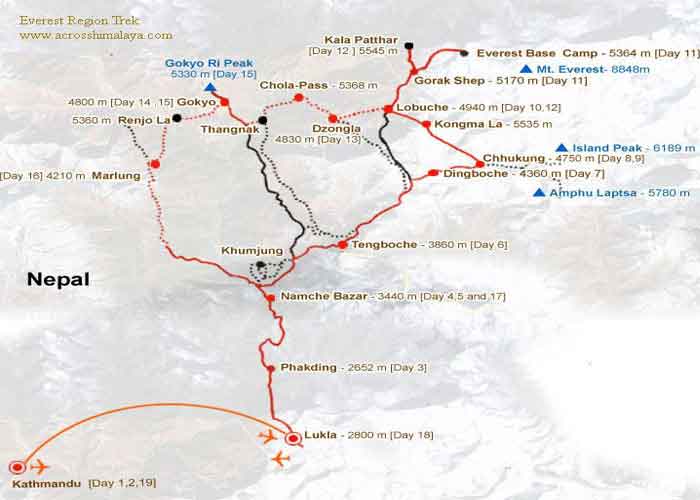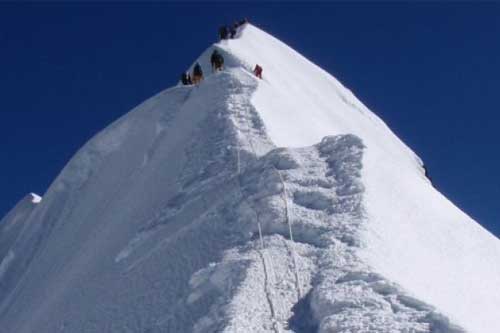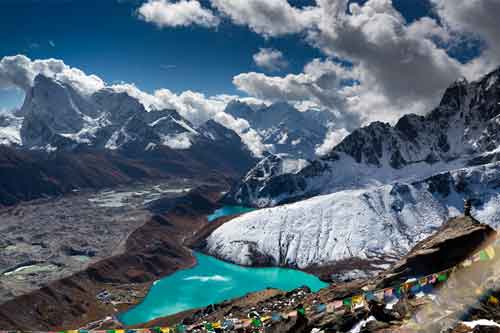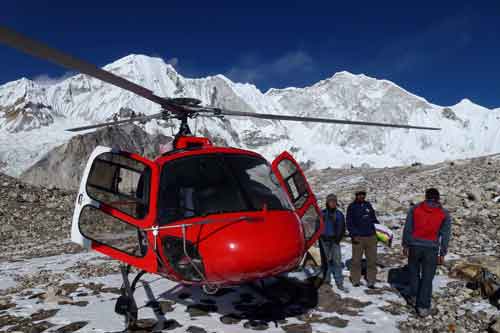EBC with Ama Dablam Expedition

The Everest region, located in the eastern part of Nepal, is a popular destination for trekking and peak climbing. Home to the world's highest mountain, Mount Everest, this region is also known for its stunning natural beauty and rich cultural heritage. Trekking and peak climbing in the Everest region offer a unique opportunity to explore the Himalayan wilderness while experiencing the local culture and traditions. Trekking in the Everest region is a popular activity among adventure seekers. The most popular trekking route in the region is the Everest Base Camp Trek, which takes you through the Khumbu Valley and offers stunning views of the Himalayan peaks, including Mount Everest, Lhotse, Nuptse, and Ama Dablam. The trek takes around 12-14 days to complete and passes through traditional Sherpa villages, Buddhist monasteries, and high-altitude landscapes.
Peak climbing is another popular activity in the Everest region. The region is home to several peaks that offer a challenging and rewarding climbing experience. Some of the popular peaks for climbing in the Everest region include Island Peak, Lobuche Peak, Mera Peak, and Ama Dablam. These peaks range in altitude from 6,000 to 6,900 meters and require technical climbing skills and experience. Climbing in the Everest region provides a unique opportunity to challenge yourself and experience the breathtaking beauty of the Himalayan mountains. When planning your trekking or peak climbing trip in the Everest region, it is important to consider the best time to visit. The best time to trek and climb in the Everest region is from March to May and from September to November. During these months, the weather is usually clear, and the visibility is excellent, providing stunning views of the mountains.
Trekking and peak climbing in the Everest region offer a unique opportunity to experience the natural beauty and rich cultural heritage of Nepal. Whether you are a seasoned trekker or a novice climber, the Everest region has something to offer everyone. So, pack your bags and get ready to explore the Himalayan wilderness!
EBC Trek with Ama Dablam Expedition Itinerary
Day 01: Arrival in Kathmandu
Arrive at Tribhuvan International Airport in Kathmandu, Nepal's capital. Transfer to your hotel, meet your climbing guide, and attend a pre-expedition briefing.
Day 02: Kathmandu Sightseeing and Preparation
Spend the day exploring Kathmandu and visit UNESCO World Heritage Sites like Pashupatinath Temple, Boudhanath Stupa, and Kathmandu Durbar Square. Prepare and organize necessary equipment for the expedition. Overnight stay in Kathmandu.
Day 03: Flight to Lukla and Trek to Phakding
Take an early morning scenic flight from Kathmandu to Lukla. Start trekking towards Phakding (2,610 meters) through lush forests and picturesque villages along the Dudh Koshi River. Overnight stay in Phakding.
Day 04: Trek to Namche Bazaar
Continue trekking along the Dudh Koshi River, crossing suspension bridges and passing through Sagarmatha National Park. Arrive at Namche Bazaar (3,440 meters), the bustling Sherpa town and the gateway to the Everest region. Overnight stay in Namche Bazaar.
Day 05: Acclimatization Day in Namche Bazaar
Spend a day in Namche Bazaar for acclimatization. Take a short hike to Syangboche Airstrip or Khumjung Village to enjoy panoramic views of Everest, Ama Dablam, and other peaks. Overnight stay in Namche Bazaar.
Day 06: Trek to Tengboche
Continue trekking to Tengboche (3,867 meters), home to the famous Tengboche Monastery. Enjoy magnificent views of Everest, Ama Dablam, and other peaks. Attend the evening prayer ceremony at the monastery. Overnight stay in Tengboche.
Day 07: Trek to Dingboche
Trek from Tengboche to Dingboche (4,410 meters), a beautiful village nestled in a high valley. Enjoy stunning views of Everest, Lhotse, and Ama Dablam along the way. Overnight stay in Dingboche.
Day 08 - 09: Acclimatization and Training in Dingboche
Spend three days in Dingboche for acclimatization and training. Your climbing guide will provide training on mountaineering techniques, equipment use, and safety measures. Take short hikes to higher altitudes for acclimatization purposes. Overnight stays in Dingboche.
Day 10: Trek to Lobuche
Continue trekking to Lobuche (4,940 meters), a small settlement located close to the Khumbu Glacier. The trail offers incredible views of peaks like Nuptse, Pumori, and Khumbutse. Overnight stay in Lobuche.
Day 11: Trek to Everest Base Camp and Gorak Shep
Trek from Lobuche to Everest Base Camp (5,364 meters), a challenging but rewarding journey. Explore the base camp, take pictures, and soak in the awe-inspiring surroundings. Trek back to Gorak Shep (5,160 meters) for overnight stay.
Day 12: Hike to Kala Patthar and Trek to Ama Dablam Base Camp
Early morning hike to Kala Patthar (5,545 meters) for a panoramic sunrise view of Everest, Lhotse, and other peaks. Descend to Gorak Shep and then trek to Ama Dablam Base Camp (4,570 meters). Set up the base camp for the Ama Dablam Expedition. Overnight stay at Ama Dablam Base Camp.
Day 13-25: Ama Dablam Expedition
Embark on the Ama Dablam Expedition, guided by experienced climbing Sherpas. Ascend through various camps, including Camp 1 (5,700 meters), Camp 2 (6,000 meters), and Camp 3 (6,300 meters). Acclimatize, train, and make summit attempts based on weather conditions and team fitness. Summit Ama Dablam (6,812 meters) if conditions permit. Descend back to the base camp.
Day 26: Trek to Namche Bazaar
Trek back from Ama Dablam Base Camp to Namche Bazaar, retracing your steps through scenic landscapes. Celebrate the successful expedition with your climbing team. Overnight stay in Namche Bazaar.
Day 27: Trek to Lukla
Continue the trek downhill, crossing suspension bridges and enjoying the last glimpses of the majestic mountains. Arrive at Lukla and celebrate the completion of your expedition. Overnight stay in Lukla.
Day 28: Flight to Kathmandu
Take an early morning flight from Lukla to Kathmandu. Spend the day in Kathmandu, relaxing, shopping for souvenirs, or exploring the city.
Day 29: Departure
Transfer to the airport for your departure, or extend your stay to explore more of Nepal's attractions.
Costs included:
- Airport transfers in Kathmandu.
- Accommodation in Kathmandu (before and after the expedition).
- Accommodation during the trek and expedition in teahouses, tents, or base camp.
- Meals (breakfast, lunch, and dinner) during the trek and base camp stay.
- Climbing permits and entry fees for Sagarmatha National Park.
- Liaison officer fees for the expedition.
- Expedition support staff, including climbing Sherpas and porters.
- Mountaineering equipment and gears (such as tents, ropes, ice axes, crampons, etc.).
- Oxygen cylinders and high-altitude medical kits.
- Insurance coverage for climbing Sherpas and support staff.
- Internal flights (Kathmandu to Lukla and return).
Costs excluded:
- International flights to and from Kathmandu.
- Nepalese visa fees.
- Personal travel insurance (including evacuation and medical insurance).
- Personal climbing equipment and gears.
- Personal expenses such as additional meals, snacks, drinks, and tips.
- Extra nights' accommodation in Kathmandu due to delays or early return.
- Charges for excess baggage on flights.
- Costs incurred in case of early termination of the expedition.
- Additional services not mentioned in the inclusions.
Fixed Departure Date
| Start Date |
End Date |
Trip Price | Availability | Book This Trip |
| 2024/2025 | March 14, | USD $ 4500 | Conformed | Book Now |
Note: If the above departures dates are not matched for you may request own your suitable date!
Useful Information
Is prior mountaineering experience required for the Ama Dablam Expedition?
- Yes, prior mountaineering experience is essential for the Ama Dablam Expedition. It is recommended to have prior experience in high-altitude trekking and basic mountaineering skills. Familiarity with techniques like using crampons, ice axes, and fixed ropes is crucial. It is also beneficial to have experience in climbing other peaks above 6,000 meters.
How physically fit do I need to be for the EBC with Ama Dablam Expedition?
- The expedition requires a high level of physical fitness. You should engage in regular cardio exercises, strength training, and endurance-building activities before the expedition. It is recommended to consult with a professional trainer or mountaineering guide to design a suitable fitness training plan.
What is the best time for the EBC with Ama Dablam Expedition?
- The best time for the expedition is during the pre-monsoon (spring) and post-monsoon (autumn) seasons. The pre-monsoon season, from March to May, offers stable weather conditions and clear views. The post-monsoon season, from September to November, is known for its favorable weather, less rainfall, and excellent visibility. These seasons provide the best chances for a successful climb.
Do I need a climbing permit for Ama Dablam?
- Yes, you need a climbing permit for Ama Dablam. The permit can be obtained through the Department of Tourism in Nepal. It is recommended to apply for the permit well in advance through a registered expedition agency or trekking operator.
What type of accommodation can I expect during the expedition?
- Accommodation during the expedition may vary. In Kathmandu, you will stay in a hotel or guesthouse. During the trek, teahouses or lodges along the trail provide basic accommodation with shared rooms and communal facilities. In higher altitudes, tented camps are set up for the expedition team.
How long does the Ama Dablam Expedition take?
- The duration of the expedition can vary, but it typically takes around 4-6 weeks. This includes the trek to Everest Base Camp, acclimatization periods, and the climbing period on Ama Dablam itself.
Is it possible to customize the itinerary or combine the expedition with other treks?
- Yes, it is possible to customize the itinerary to meet your specific preferences and requirements. You can consult with trekking operator to discuss your needs and customize the itinerary accordingly. Additionally, it is possible to combine the Ama Dablam Expedition with other treks in the Everest region, such as the Three Passes Trek or Gokyo Lakes Trek.






